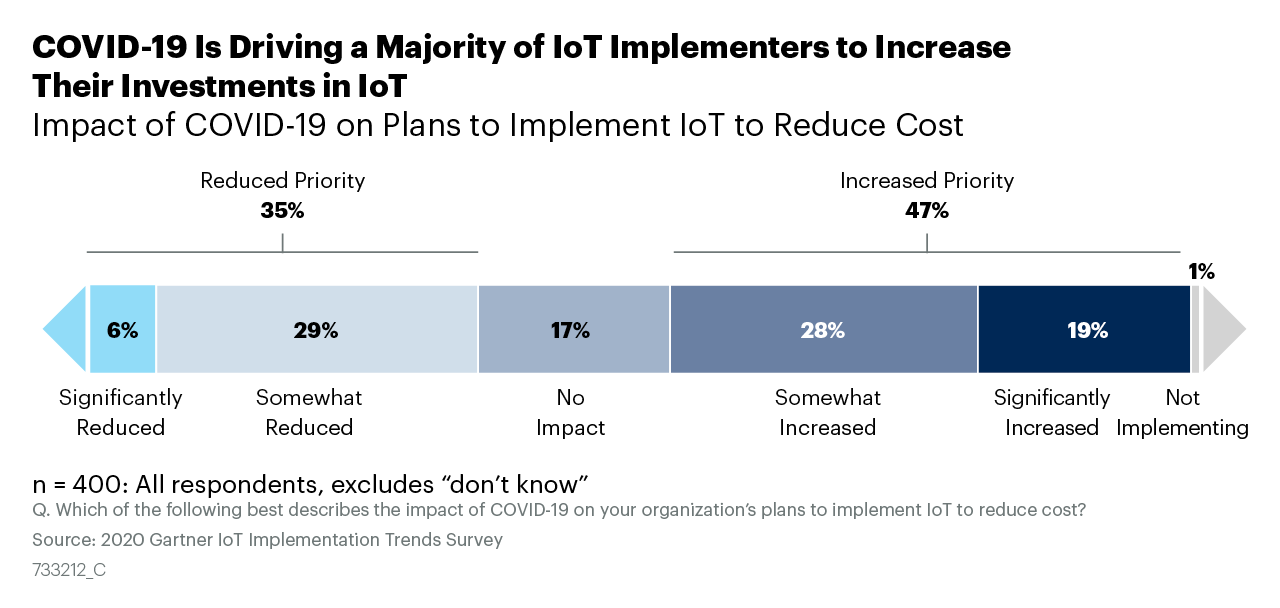by Brianna Crandall — November 30, 2020 — Despite the disruptive impacts of COVID-19, 47% of organizations plan to increase their investments in the internet of things (IoT), according to a recent survey from global research and advisory company Gartner.
Following the COVID-19 lockdown, the survey found that 35% of organizations reduced their investments in IoT, while a larger number of organizations are planning to invest more in IoT implementations to reduce costs (see Figure 1).

Figure 1. Impact of COVID-19 on Plans to Implement IoT to Reduce Costs. Source: Gartner (October 2020). Click to enlarge.
According to Gartner, one reason behind the increase is that while companies have a limited history with the internet of things, IoT implementers produce a predictable return on investment (ROI) within a specified timeframe. “They use key performance indicators (KPIs) to track their business outcomes, and for most of them they also specify a time frame for financial payback of their IoT investments, which is on the average three years,” said Benoit Lheureux, research vice president at Gartner.
In addition, as IoT investments are relatively new, most companies have plenty of “low-hanging fruit” cost-saving opportunities to pursue, such as predictive maintenance on commercial and industrial assets like elevators or turbines, and optimization of processes such as increasing manufacturing yield.
Digital twins and AI drive IoT adoption
As a result of COVID-19, 31% of survey respondents said that they use digital twins to improve their employee or customer safety, such as the use of remote asset monitoring to reduce the frequency of in-person monitoring, such as of hospital patients and mining operations.
The survey showed that 27% of companies plan to use such digital twins as autonomous equipment, robots or vehicles. “Digital twins can help companies recognize equipment failures before they stall production, allowing repairs to be made early or at less cost,” said Mr. Lheureux. “Or a company can use digital twins to automatically schedule the repair of multiple pieces of equipment in a manner that minimizes impact to operations.”
Gartner expects that by 2023, one-third of mid-to-large-size companies that implemented IoT will have implemented at least one digital twin associated with a COVID-19-motivated use case.
The enforcement of safety measures has also fueled the adoption of artificial intelligence (AI) in the enterprise. Surveyed organizations said they have applied AI techniques in a pragmatic manner. One-quarter (25%) of organizations are favoring automation (through remote access and zero-touch management), while 23% are choosing procedure compliance (safe automation measures) in order to reduce COVID-19 safety concerns. For example, organizations can monitor work areas using AI-enabled analysis of live video feeds to help enforce safe social distancing compliance in high-traffic areas such as restaurants and manufacturing lines.
Gartner expects that by 2023, one-third of companies that have implemented IoT will also have implemented AI in conjunction with at least one IoT project.
The survey was conducted online from June through July 2020, with 402 respondents across the US, UK, Germany, Australia, Singapore and India.
Gartner clients can read more in Survey Analysis: COVID-19 Use Cases Are Driving IoT Adoption, Powered by Innovations Like AI and Digital Twins.
Additional analysis on current and future trends of AI will be presented during the Gartner IT Symposium/Xpo 2020 conferences for CIOs and other IT executives. Upcoming dates and locations for Gartner IT Symposium/Xpo include:
- November 9-12| EMEA| Virtual
- November 17-19| Japan| Virtual
- November 23-25| India| Virtual




